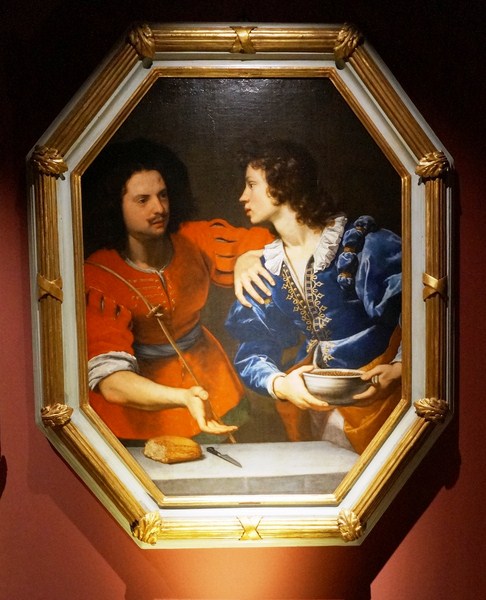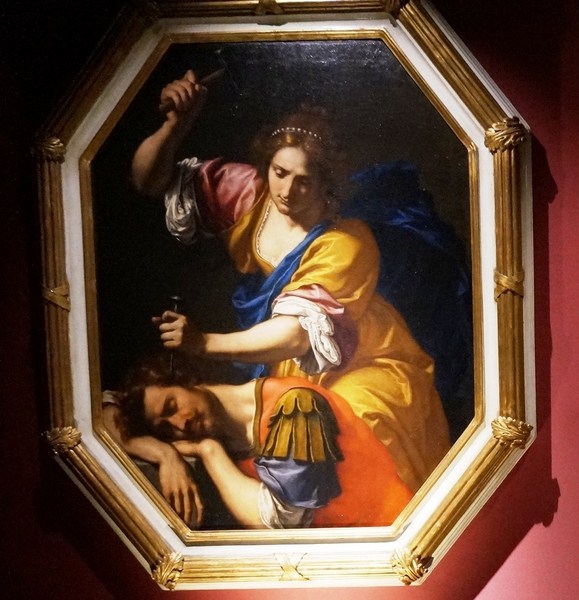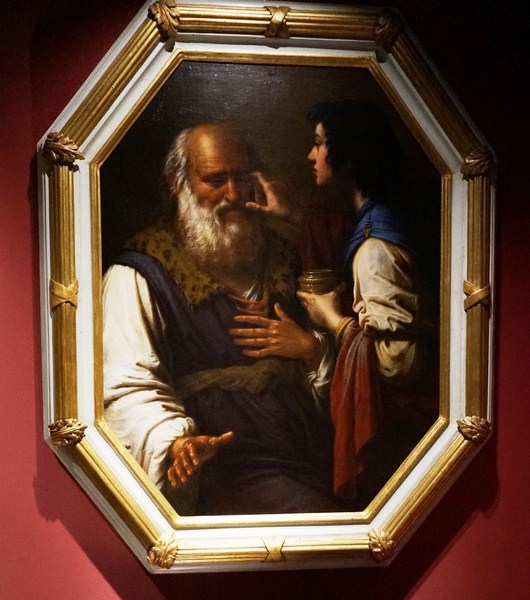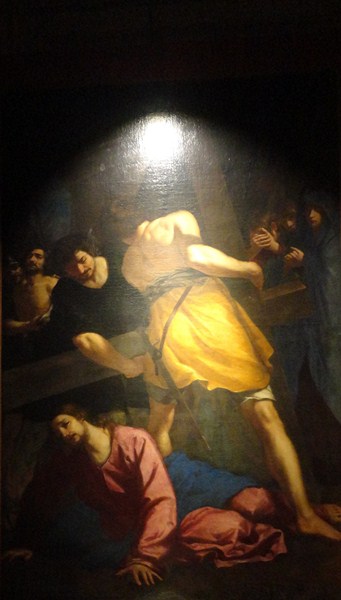 |
| Rigor and Grace. The Confraternity of San Benedetto Bianco in 17th-century Florence (Rigore e la Grazia. La compagnia di San Benedetto Bianco nel Seicento Fiorentino) |
One of the temporary exhibits
we encountered during our tour of the Palazzo Pitti is the Il Rigore e la
Grazia. La compagnia di San Benedetto Bianco nel Seicento Fiorentino (Rigor
and Grace. The Confraternity of San Benedetto Bianco in 17th-century Florence),
a unique art exhibition of little-known paintings made by great 17th
century masters for the Brotherhood of San Benedetto Bianco, one of the
most important secular brotherhoods of Florence. Supposed to be held only from
October 22, 2015 to May 17, 2016, it must have been extended as our visit was
almost two weeks after its supposed end.
 |
| Crucifixion (Ferdinando Tacca) |
The Brotherhood of San
Benedetto Bianco, founded in 1357 in the Camaldolese
monastery of San Salvatore, later moved to the Great Cloister of the
Dominican convent of Santa Maria Novella and
then moved permanently inside the Old Cemetery and, more specifically, in the
halls built by Giorgio
Vasari in 1570, where it remained.
 |
| Esau Sells his Birthright (Lorenzo Lippi, 1645) |
In 1866 the headquarters of the Brotherhood became the little-known
19th-century church along Orti Oricellari Street. It was then moved to the
parish of Santa Lucia sul Prato. Before its dissolution in 1940, the
congregation donated, to the Florentine Curia, the entire artistic heritage
acquired over the centuries, which was (partly) deposited in the Major Seminary
of Cestello, where it remains today.
 |
| Jael and Sisera (Antonio Ruggeri, 1648) |
One of the most important and
prestigious Florentine lay groups, at the center of the Confraternity’s
spirituality was the sacrifice of Christ which is a recurring theme in the
works commissioned and purchased by the Confraternity. This must-be-seen art exhibition,
held in the annexes attached to the Palatine Chapel in the Museo Degli Argenti,
featured 36 works, 21 of which have been finely and meticulously renovated and
restored to their original splendor. Of the 21, 14 were paintings while
others were a fresco, a
sculpture in papier-mâché,
a manuscript and three cups, all belonging to the Archbishop’s Curia and
various Florentine churches.
 |
| Jeroboam and the Prophet Ahijah (Vincenzo Dandini) |
Two wonderful paintings, depicting
St. Julian (San Giuliano) and St Benedict,
by Cristofano
Allori, were brought to light by the restoration after the damages suffered
during the terrible flood of 1966. Initially, the tables were united and formed
the great altarpiece that protected the relics on the altar of the
Brotherhood. Thanks to a special mechanism, the altarpiece could then be
spectacularly raised on the occasion of the exposition of the relics of the two
saints.
 |
| Lot and his Daughters (Simone Pignoni) |
Intending to present the audience
with a sort of rediscovered secret treasure, these were paintings by
artists such as Ferdinando
Tacca, Vincenzo
Dandini, Agostino
Melissi, Carlo
Dolci, Matteo
Rosselli, Lorenzo
Lippi, Mario
Balassi, Onorio
Marinari and Cristofano Allori who,
through their work, wanted to embellish the premises of the brotherhood.
 |
| Repudiation of Agar (Giovanni Martinelli) |
The art exhibition was, also above
all, a unique opportunity to admire the splendid Palatine Chapel, at the
ground floor of the Pitti
Palace, from the inside. Though the chapel always remained a place of
worship, it was, usually, opened to the public only on rare occasions. Also,
thanks to the dedicated restorations and the new exhibition rooms, which have
also been renovated and added to the exhibition halls of the Museo degli
Argenti, it was also a way to protect and enhance the cultural heritage of
Florence.
 |
| St. Benedict and St. Julian (Cristofano Allori) |
The exhibition wound
through three rooms located to the left of the Palatine Chapel which, as well
as the adjacent buildings, were once part of a large apartment that was home to
numerous members of the House of Medici,
including Cosimo
II and his wife Marguirite-Luise d ‘Orléans and Grand Duke of
Tuscany Cosimo
III de’ Medici. It was only in 1765 that Peter Leopold, Duke of Lorraine,
ordered that the salon be transformed into the current chapel.
 |
| Flagellation of Christ (Agostino Melissi) |
The exhibition was made particularly
interesting by several study findings. Through a large and precise
archival work, the authors of the essays in the catalog were able to retrieve
some valuable documents which show the original furnishings of the
Palatine Chapel as well as those of the historical site of the Brotherhood
in Santa Maria
Novella Cathedral.
 |
| Susannah and the Elders (Agostino Melissi, 1648) |
The painstaking work has also helped
to establish the paternity of works and paintings made for San Benedetto Bianco
by famous artists such as Agostino Melissi, Jacopo Vignali and Volterrano but,
above all, to retrieve the archival collection of the Zuti family, a very
important document not only, from the artistic point of view of the city, but
also useful to define its history.
 |
| The Finding of Moses (Jacopo Vignali, 1645-46) |
Eight paintings, with Biblical
subjects, bear the signatures of some of the most celebrated artists of
the Seicento in
Florence. They represent scenes from the Old Testament which
refer to facts that really happened to brother Gabriele Zuti, linked to the
scourge of the plague in 1630. The eight are Repudiation of Agar (Giovanni Martinelli), Jacob
and Esau (Lorenzo
Lippi), Healing of Tobias (Mario Balassi), Jael
and Sisera (Ottavio
Vannini), Lot and the Daughters (Simone Pignoni), Finding
of Moses (Jacopo
Vignali), Susanna and the Elders (Agostino Melissi)
and Jeroboam and the Prophet Ahijah (Vincenzo Dandini).
 |
| The Healing of Tobias (Mario Ballassi, 1645) |
These masterpieces are, certainly,
the most important donation received by the Brotherhood. The brother
Gabriele Zuti commissioned it around 1650 to beautify his house and then gave
it to St Benedict at the time of his death in 1680.
 |
| The Altar of the Confraternity |
Michel Scipioni, Alessandro
Grassi and Giovanni Serafini, the young curators of this exhibition, were able
to express the best of the art and spirituality of the Brotherhood by
highlighting its main feature – the propensity to seriousness and discipline
but also to beauty.
 |
| Jesus Falls Under the Weight of the Cross (Vincenzo Dandini) |
Rigor and Grace. The
Confraternity of San Benedetto Bianco in 17th-century Florence: Palatine
Chapel, Pitti Palace, Piazza de’ Pitti, 1, Florence, Italy. Tel:+39 055 294883. Open
Tuesdays-Sundays, 8:15 AM – 6:50 PM. Admission: Palatine Gallery (€8.50),
Silver Museum (€6.00), Gallery of Modern Art (€8.50), Costume Gallery/Porcelain
Museum/Boboli Gardens/Bardini Garden (€6.00).
How to Get There: Take the C3 or D bus to
the Pitti stop.

 It was now evening when we
ended our tour of the Rialto Bridge and it was now time for supper. We wanted
to try a specialty of Venice - Spaghetti al nero di seppia (squid ink
spaghetti). You can find this pasta dish in many authentic Venetian osterie or
trattorias but one of the best that offers this dish is Trattoria alla Madonna,
also said to have the best Seafood Risotto in Venice.
It was now evening when we
ended our tour of the Rialto Bridge and it was now time for supper. We wanted
to try a specialty of Venice - Spaghetti al nero di seppia (squid ink
spaghetti). You can find this pasta dish in many authentic Venetian osterie or
trattorias but one of the best that offers this dish is Trattoria alla Madonna,
also said to have the best Seafood Risotto in Venice.  It was very close to Rialto Bridge,
a block off the Grand Canal but, as it was off the beaten path, we still needed
to seek it out. We found La Madonna on a narrow alley far from the maddening
crowd, in one of the most charming corners of the city.
It was very close to Rialto Bridge,
a block off the Grand Canal but, as it was off the beaten path, we still needed
to seek it out. We found La Madonna on a narrow alley far from the maddening
crowd, in one of the most charming corners of the city.
 The walls of the nine dining rooms
of this popular and busy trattoria are all adorned with a wealth of Italian
contemporary paintings of famous Italian artists. The menu was quite varied, with
lasagna, spaghetti and soup but the fish dishes predominate.
The walls of the nine dining rooms
of this popular and busy trattoria are all adorned with a wealth of Italian
contemporary paintings of famous Italian artists. The menu was quite varied, with
lasagna, spaghetti and soup but the fish dishes predominate.













































